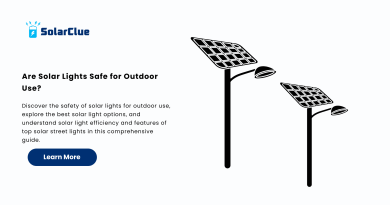Top Solar Street Lights for Rural India
Lighting up rural India is not just about convenience—it’s about safety, progress, and dignity. In areas where electricity infrastructure is either weak or nonexistent, solar street light systems are game-changers. Choosing the top solar street lights means investing in independence from the grid, lower operational costs, and long-term reliability. In this article, we’ll guide you through the best products, selection criteria, and benefits of adopting solar light solutions in villages.
Table of Contents
- 1 Why Rural Areas Need Solar Street Lights
- 2 Key Benefits of Installing Solar Street Lights in Rural India
- 3 Types of Solar Street Lights
- 4 Features to Look for in the Best Solar Street Light
- 5 Top Solar Street Light Models for Rural India
- 6 Installation and Cost Considerations
- 7 Government Programs Supporting Solar Lighting
- 8 Real-Life Impact
- 9 Expert Tips for Rural Buyers
- 10 Common Myths
- 11 FAQs
Why Rural Areas Need Solar Street Lights
Millions of rural homes in India still experience frequent power cuts or lack public lighting infrastructure altogether. This limits outdoor activities, endangers travel after sunset, and hampers community security. A solar street light harnesses solar energy to illuminate roads, public spaces, and homes—without needing grid electricity.
With India’s push for rural development and sustainable energy, the demand for solar lights has surged. From small hamlets in Bihar to tribal settlements in Maharashtra, these lights are brightening lives.
Key Benefits of Installing Solar Street Lights in Rural India
- Energy Independence: Operate without electricity from the grid.
- Eco-Friendly: Powered by renewable energy, no carbon emissions.
- Low Maintenance: Most solar lights have a lifespan of over 10 years with minimal upkeep.
- Enhanced Safety: Reduces crime and accidents after dark.
- Cost-Effective: One-time investment with zero electricity bills.
Types of Solar Street Lights

Understanding the options helps in selecting the best solar street light for rural setups:
1. Stand-Alone Solar Street Lights
Each light works independently with a built-in solar panel and battery. These are ideal for remote villages with no central control system.
2. Centralized Solar Lighting Systems
One large solar panel powers multiple lights. Suitable for community centers, schools, and large public areas.
3. All-in-One Solar Street Lights
Modern units with LED, solar panel, battery, and motion sensors integrated into one structure. These are increasingly popular as the top solar street lights for easy installation and minimal space usage.
Features to Look for in the Best Solar Street Light
When choosing the best solar street light, pay attention to:
- Battery Capacity: Ensure the battery lasts all night.
- Lighting Hours: Choose models offering 10–12 hours of lighting.
- Motion Sensor: Saves energy by activating full brightness only when needed.
- Waterproof Rating: A minimum IP65 rating is required for outdoor usage.
- Build Quality: Durable casing resists heat, rain, and dust.
- Solar Panel Efficiency: High-efficiency panels charge batteries quickly, even on cloudy days.
Top Solar Street Light Models for Rural India
Here are the top solar street lights trusted by villages and local governments:
Wipro Solar LED Street Light (20W)
- Bright illumination, durable aluminum frame, IP66-rated.
Havells Enviro Solar Street Light (24W)
- Great for wide-area coverage, with built-in battery and controller.
SolarClue All-in-One Solar Street Light (30W)
- Best in class with PIR motion sensor and lithium battery.
Elecssol All-in-One LED Solar Street Light (15W)
- Affordable and easy to install, ideal for narrow streets.
Tata Power Solar LED Light (9W & 12W)
- Highly efficient panels and brand trust.
Installation and Cost Considerations
Cost of solar street lights in India varies by wattage, brand, and battery type:
| Light Type | Wattage | Price Range (INR) |
|---|---|---|
| Basic LED Solar | 9–12W | ₹3,500–₹5,000 |
| Mid-Range All-in-One | 20–30W | ₹7,000–₹12,000 |
| High-End Models | 40W+ | ₹15,000–₹25,000 |
Most systems can be installed in 1–2 hours with basic tools. For larger projects, village panchayats or NGOs often partner with installers for subsidies and bulk discounts.
Government Programs Supporting Solar Lighting
India’s rural electrification programs include various solar initiatives:
- Saubhagya Scheme: Promotes decentralized solar lighting in off-grid villages.
- MNRE Subsidies: Provides up to 30% financial assistance for approved products.
- CSR Initiatives: Companies fund solar street light installations as part of social responsibility projects.
Real-Life Impact
In Jharkhand’s Gumla district, a cluster of tribal villages installed 50 solar lights with help from an NGO. Women now feel safe stepping out at night, students gather at the community center for evening studies, and petty crimes have reduced dramatically.
Expert Tips for Rural Buyers
- Choose motion sensor lights for better battery life.
- Prefer lithium batteries over lead-acid for longevity.
- Install lights at 12–14 feet height for better spread.
- Use galvanized poles to prevent rusting.
- Always verify IP rating for dust and water resistance.
Common Myths
Myth 1: Solar lights don’t work on rainy days.
Truth: They still charge in cloudy conditions and store power for 2–3 days.
Myth 2: Maintenance is costly.
Truth: Most solar street lights are maintenance-free for 5–10 years.
Myth 3: They aren’t bright enough.
Truth: Modern LED solar lights provide strong illumination equal to traditional sodium lamps.
FAQs
1. What is the life of a solar street light?
Usually 7–10 years, depending on battery and build quality.
2. Are solar lights suitable for rural roads?
Yes, especially all-in-one and stand-alone types.
3. Can they be installed without an electrician?
Basic models can be DIY-installed; advanced setups need professionals.
4. What wattage is best for a village lane?
15W to 30W is sufficient for narrow roads and paths.
5. Are government subsidies available?
Yes, especially under MNRE or rural electrification schemes.
Lighting up the heart of India starts with smart, sustainable decisions. Browse our curated collection of solar street lights at solarclue.com and dive into expert tips, funding guides, and rural success stories at blog.solarclue.com—because brighter villages mean a brighter future for all.




